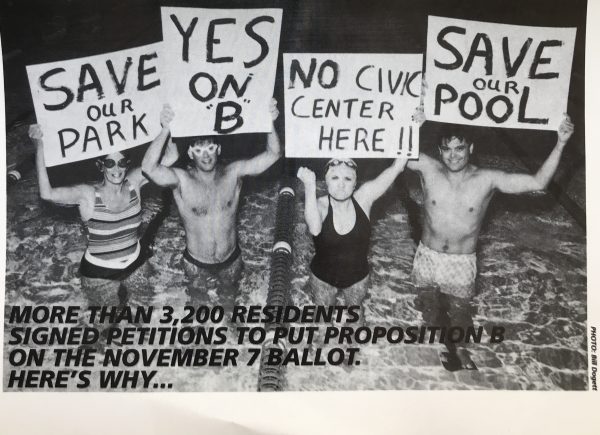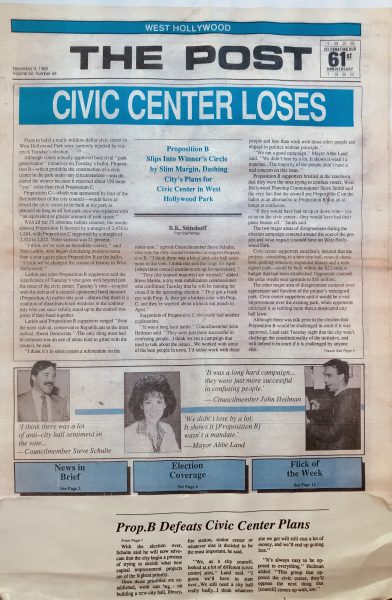
2019 has been a year of anniversaries. We celebrated the 50th anniversary of the Stonewall Riots in June, and in November we will commemorate West Hollywood’s 35th birthday. But I was recently reminded of an important date the city is not likely to commemorate, the 30th anniversary of the “Save the Park” Initiative.
When we incorporated the city in 1984, our municipal government had a grassroots, ad hoc sensibility that was in keeping with concepts of “people power” and participatory democracy that was the hallmark of the incorporation campaign. City Council meetings were held in the auditorium of West Hollywood Park, and City Hall was a rented space that is currently the Trader Joe’s across from 24 Hour Fitness. City government was accessible and unpretentious, which was reflected in our well-attended City Council meetings and participation in municipal governance. Our city budget was modest compared to today.
Much of that grassroots sensibility changed in 1986 when Valerie Terrigno was forced to step down due to financial improprieties that occurred when she was working at a non-profit prior to incorporation. John Heilman became the de facto leader as he headed a three-person majority on the new Council.
West Hollywood had been born in the glare of international publicity, and the city adopted a raft of progressive policies that reflected the progressive values of the community. But the limelight affected some of the Council members who began to feel self-conscious about our modest City Hall and conducting meetings in an auditorium. There was a move toward a nascent cult of personality at City Hall. The source of progressive policies that had previously been seen as a reflection of community values was now being attributed to the leadership of the Council. It was a subtle shift, but it was one that tended to disempower the activists that had been the foot soldiers of the Cityhood campaign.
In 1988 the city unveiled plans to create a “civic center” in West Hollywood Park. A new city hall with Council chambers that would also incorporate an expanded library would be constructed in West Hollywood Park. There would be a spacious parking structure. At the time, West Hollywood Park was only about two-thirds of the size it is now, as the county had buildings on the south end of the park as well as a parking lot that had not been ceded to the city at that point. Clearly this proposal would radically change the nature of the park.
There was immediate skepticism. We would be losing our only municipal swimming pool, baseball diamond, and the auditorium. The $25 million price tag seemed totally unrealistic.
Only one Council member questioned the scope of the project; Steve Schulte. A Yale graduate, former executive director of the Gay and Lesbian Center and a former Colt model, Schulte was both an independent voice on the Council and an icon within the gay male community. Tom of Finland was enthralled; Schulte was his muse, and his image graced many of Tom of Finland’s finest works.
Schulte felt the estimated cost of construction was unrealistic and that the real cost would be closer to $50 million. He feared that once the project was launched the real cost would create a huge impact on our then limited municipal budget. Schulte also tactlessly expressed that the project was a bit pretentious given the challenges faced by the young city.
At the time street prostitution was rampant on the Eastside and on the Sunset Strip. Santa Monica Boulevard was as cratered as the far side of the moon. Both of our parks had suffered from years of neglect and demand for social services was burgeoning, particularly in light of the looming AIDS crisis. Schulte felt our limited resources should first be focused on public safety, street repairs, and social services, and he feared this project would be a drain from real priorities.
But what really fueled opposition to the Civic Center in the park was the loss of green space and the loss of the pool.

At this point, the city made a huge blunder. John Heilman and company declared that the new civic center would not result in the loss of “open space” and that with the help of a “rooftop garden” there would not be any loss of green space.
That just insulted peoples’ intelligence.
It was clear we were losing green space and recreational space that would never be replaced. We were losing a pool and a baseball diamond while the city was counting flower beds and balconies toward “open space.” No matter how you cut it, we were losing a park. Schulte announced that he was organizing a ballot measure to “Save the Park”.
In early 1989 Schulte put together a grassroots committee that was chaired by Tom Larkin, a local realtor and head of the local Log Cabin Republican Club.
Schulte had befriended me during the Cityhood campaign, but we had not been particularly close. But I volunteered to collect signatures along with an eclectic group of park loyalists. The city’s response was to label the opposition as “malcontents,” and it mobilized the city establishment to block the signature gathering.
The signature gathering was a tedious process of going door to door, and it was difficult to get volunteers. Although we collected a substantial number of signatures, the “Save the Park” campaign seemed to falter as the deadline to turn in our initiative loomed.
On the Friday before the last weekend to collect signatures to meet the deadline to qualify the measure, I called Tom Larkin asking about what we were doing. Tom told me that it looked hopeless and that a decision had been made to stop collecting signatures. I was stunned after putting in so much time, but I was just a lowly volunteer.
Rather than being discouraged I got mad. I asked Larkin if I could still collect signature, to which he said “good luck.” I took that as a challenge.
I immediately called a couple of people I knew I could count on. First was Norman Chramoff, an old Coalition for Economic Survival grassroots operative. Norman was always up for anything. Then I called Roz Krause, a swimmer, and devotee of the WeHo pool, who along with her husband Stan Lothridge could always be counted on. I also called my neighbor on Huntley, Gloria Vassey.
We ran all over town for the next three or four days gathering signatures. What Larkin had not counted on is that after months of work within the community, suddenly our message was resonating. It seemed like the five of us were collecting dozens of signatures every hour.
At the end, we were like zombies, but when we turned in our petitions, we had the signatures to qualify for the November ballot.
Once we qualified the effect was electric. Suddenly we had volunteers. The West Hollywood Swim Team, which had been on the fence as an organization, came out in favor of our initiative. Their support was crucial. How do you argue with guys in Speedos?
City Hall was stung and fought back by placing a competing “Save the Park” measure on the ballot. The city did not have to collect signatures for its bogus initiative; it had four votes on the Council to put it on the ballot. The city’s measure said it was okay to build the civic center as long as there was not a net loss in open space, “open space” being left open to the city’s interpretation. Many felt this move was a disingenuous attempt to thwart the democratic process.
I remember the campaign as being a lot of fun, but I suppose I am odd that way. In October, just a few weeks before the election, this young guy walked into our meeting saying he had just moved into town from Michigan. He wanted to volunteer, saying he “wanted to be on the right side.” I think Jeff Prang was only 24 years old at the time but it was the start of his career in activism in West Hollywood.
Although we had no money and were outspend by John Heilman’s organization, the opposition had no volunteers or dedicated support. City insiders were pressed into service without a lot of enthusiasm. Voters were confused by the two measures, which was a challenge. But on Election Day we scored a convincing victory over City Hall.
In defeat, John Heilman was petulant. “They were just more successful in confusing people,” Heilman said in an article in the West Hollywood Post; “We worked with some of the best people in town. I’d rather work with these people and lose and work with those other people and engage in politics without principle.” Abbe Land was more gracious, saying “we ran a good campaign,” and then she said she would not undermine the will of the people.
While we will be dedicating a newly designed West Hollywood Park in the near future, I doubt if anyone will acknowledge that the “Save the Park” campaign actually made the new incarnation of the park possible. The pool that would have been demolished 30 years ago is still in use. When I was on City Council I found money to invest in its renovation so that it could function all year long. I always felt really good about my role in this effort.
While some folks at City Hall would love to forget this episode in our city’s history, it is actually a great chapter that reflects that the people of West Hollywood, despite challenges, have the ability to take control of the direction of their community. You can fight City Hall, and sometimes you just have to.

It seems WeHo has been engaged in “Save the Park” efforts since I moved here 30 years ago. I confess to liking the former”West Hollywood Park” better, but my loyalties lie with Plummer Park – a wonderful fight for a “if it ain’t broke don’t fix it” park that now has landmark status. I wonder are there so few concerns in this little burgh that we devote so much time and energy to such endeavors. I know how much energy and time I devoted to Saving Plummer Park . My other friends did even more. And now this lovely little… Read more »
This is the sort of history (lesson) our younger residents need to know. It may encourage them to be more politically involved and concerned with our evolving needs as the city lurches ahead – hopefully, ahead.
Made me feel nostalgic for the days when one could attend a city council meeting one night, followed by a Hay Ride the next night, in that beautifully dingy old community space. The best part is that one could find parking to do both, without mortgaging the future. West Hollywood has lost its identity and its raison d’etre at the hands of over-development and political grandstanding, opportunism, and ego.